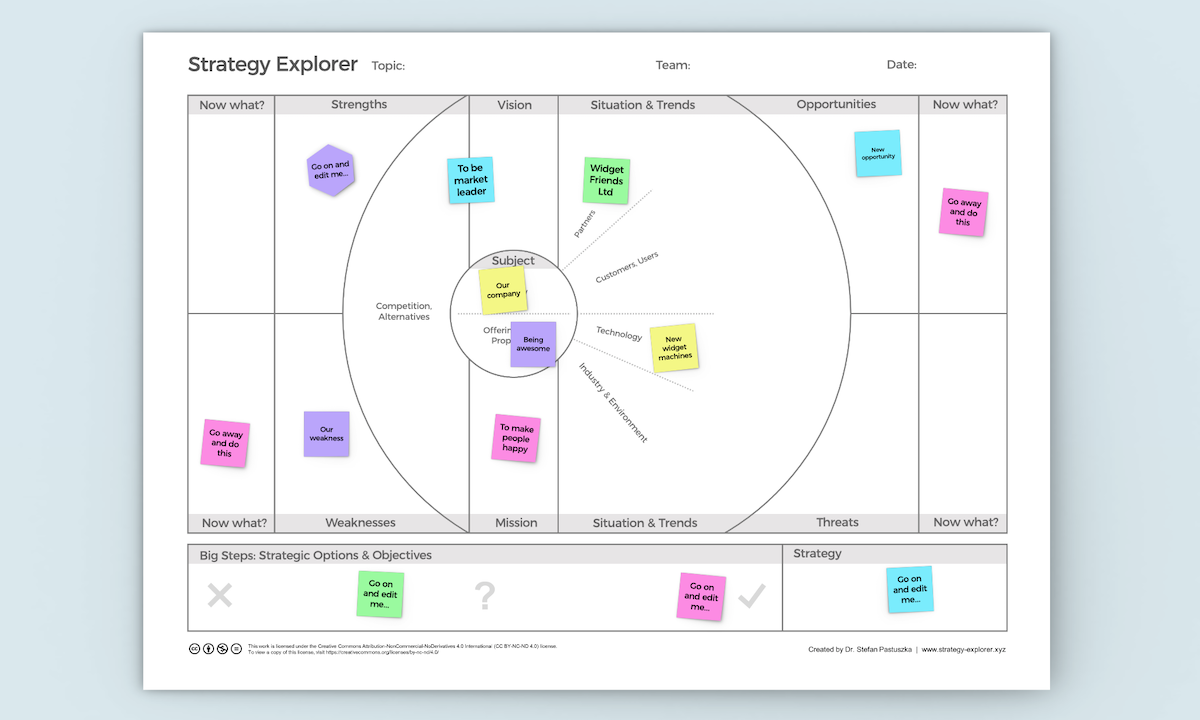Strategy Explorer
The Strategy Explorer is a method developed by Dr. Stefan Pastuszka to help guide you through the creation of a strategy for your team, business or problem.
Stefan has developed an in depth 6 part guide to using the Strategy Explorer, but we’ll give you a quick overview here to get you started:
Step 1 - Subject
Start at the center circle of the Strategy Explorer canvas and ask: What are you developing a strategy for? The subject consists of two parts:
- An entity, such as an organization, person, or product;
- and its offering, such as a product or service, connected to a certain value proposition.
Take some time to define these for your session, and add sticky notes to the canvas to capture your subject.
Step 2 - Goal
Going vertically up and down from the Subject at the center, now think about your goal. What is your Vision and your Mission? A vision is something that you want to have achieved at a certain point of time in the future, while your mission is what fundamentally drives you (your “north star”). For example, your vision might be to have 10,000 engaged users in five year’s time, while your mission is to provide a great customer experience.
Step 3 - The Outside World
Now step out to the larger inner circle, and look at the situation in the world around you that your strategy has to engage with. On the left, fill in your Competitors & Alternatives with other market players or products and services which your customers might use instead of yours.
On the right, consider the Situation & Trends at the moment:
- Partners - who are they today and who can you cooperate with to bring your strategy to life
- Customers & Users - what trends are there in your customer & user behaviours and situations (if you’re reading this in 2020, COVID-19 is almost certainly relevant to this section!)
- Technology - what new avenues has technology opened up, or will do in future
- Industry & Environment - the situation and important developments in the industry and the larger political, economic and legal environment
Step 4 - SWOT Analysis
Having set the scene in the previous steps, now focus on yourself, and your Strengths, Weaknesses, Opportunities and Threats (SWOT).
Strengths and Weaknesses are internal, and not affected by the world around you. It’s things you do well or poorly, capabilities you have or lack, and things you generally succeed or fail at. It is important to compare yourself with with the competition in order to find out what your true strengths and weaknesses are - concentrate on these!
Opportunities and Threats are from the outside - situational or environmental factors that will give you an advantage or disadvantage, or changing conditions that will be good or bad for you.
Take the items you’ve identified in your SWOT analysis and turn them into conclusions in the adjacent Now What sections. If you have a Strength, how do you capitalize on it? If you see a Threat, what can you do to mitigate it?
Step 5 - Big Steps
In the previous steps you’ve hopefully come up with lots of ideas that will take you closer to fulfilling your Mission and achieving your Vision. Now work out which are the important strategic moves and bring them into the Big Steps in the bottom left.
Find more Big Steps by looking at the big picture that has emerged from your analysis so far and see if any overall strategic ideas emerge. And also feel free to do some free-form ideation to bring in new big ideas.
Finally, order your Big Steps from left to right, where the right-hand items should definitely be done, the middle is unclear and the left-hand side is a definite no for now.
Step 6 - Strategy Formulation
In this final step, you take what you’ve learned so far and decide on an overall strategy. Distill your work so far into a written strategy which makes it clear what needs to be done, is easy to remember and is actionable.
As a starting point, you could use the following template, filling in with the items you’ve put in the Vision and Big Steps section:
We achieve [Vision] by doing X, Y, and Z [Selected Big Steps].
That’s it! You have a strategy to take away and use. You can also see the result as a “strategy prototype” which you check and substantiate in further iterations. We wish you fun and success with your strategy!
You can read more about the strategy explorer at https://strategy-explorer.xyz/ or watch the video tutorial.
